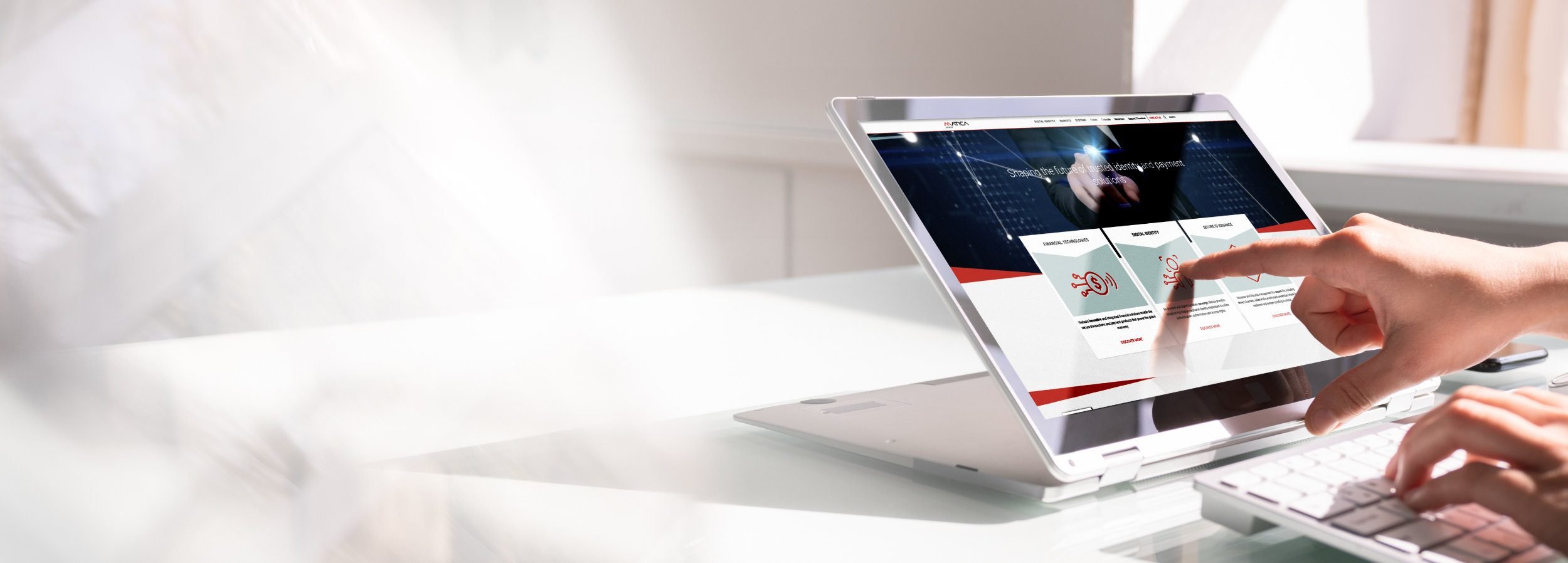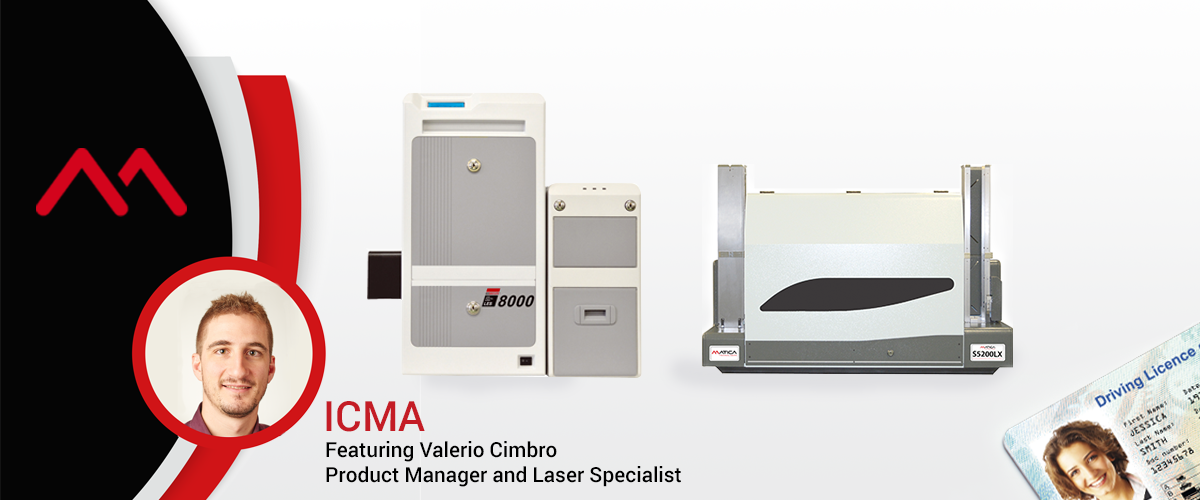Munich, Germany, Thursday 08, March, 2017 – Matica’s Product Manager and Laser Specialist, Valerio Cimbro, recently featured in 2018 February´s edition of Card Manufacturing magazine, the Official Publication of the International Card Manufacturers Association (ICMA). He describes and clarifies the features of laser technology for issuance systems and shares his knowledge about the benefits of laser-based personalization.
Laser Personalization for High-Security Cards
by Valerio Cimbro, Matica Product Manager and Laser Specialist
If you are ever prompted to talk about lasers to the uninitiated, the image of a blue or red laser saber will probably spring to mind faster than you could say ‘Yoda’. And yet, there are an enormous amount of things one can do with lasers – and none of them are linked to ‘the Force’ (no matter which side). So let’s start from the beginning: what is a laser?
A clue lies in its name. ‘Laser’ is an acronym for ‘light amplification by stimulated emission of radiation’, and the first one was built in 1960 by Theodore H. Maiman at Hughes Research Laboratories, (as in the aviator, Howard Hughes), in the US. It is a device that emits a beam of coherent monochromatic light by the stimulated emission of photons from excited atoms or molecules.
Unlike other sources of light such as old-fashioned lightbulbs, lasers produce a narrow beam of light in which all of the light waves have very similar wavelengths. The laser’s light waves travel together with their peaks all lined up, or ‘in phase’. This is why laser beams are very narrow, very bright, and can be focused into a very tiny spot. And this interesting property presents a valuable asset when it comes to using laser to issue security cards.
But before we get to cards, we should quickly recognize that the laser is also at home in a huge swathe of industry applications. Lasers exist in optical disk drives, laser printers and barcode scanners; DNA sequencing instruments; fiber-optic and free-space optical communication; laser surgery and skin treatments; cutting and welding materials; military and law enforcement devices for marking targets and measuring range and speed; and laser lighting displays in entertainment.
When it comes to cards, why are they more secure when we use laser-based issuance systems?
When we personalize cards by using a laser, we are not actually printing the card but engraving it. In other words, the laser beam is ’marking’ the card. And not only the surface of the card, because, depending on the intensity and the angle of the laser beam, we can go deeper into the body of the card and create different effects and black-color intensities. As a result, the card is much more tamper resistant; we are physically ‘modifying’ the card and this is the key point.
This is why it is important to choose the right material for the card. While we can work with different materials, polycarbonate (PC) is the recommended card material for laser personalization. Polycarbonate is a type of thermoplastic with excellent molding and thermoforming properties and it is employed for a variety of purposes, including the manufacture of indestructible eyeglasses and protecting the surfaces of DVDs, to name a few. In terms of identity documents, polycarbonate makes it possible to incorporate a significant number of additional security features, including Changeable Laser Image (CLI) transparent ‘windows’ inside a document similar in effect to watermarks on bank notes, and positive and negative embossing for tactile recognition.
Polycarbonate cards contain special layers of carbon-enriched polycarbonate. When these layers are exposed to a laser beam, the carbon reacts to form a permanent black mark, trapped inside the material. Even at temperatures as low as -35°C or as high as + 135°C, polycarbonate conserves its physical and optical properties, making it ideally suited for identity documents. That’s why government agencies around the world are increasingly requesting this material for their documents – plus, it guarantees a lifespan of 10 years.
So, thanks to its properties, the use of laser – combined with the right card material – allows a number of unique visual security features to be introduced into cards. These features are very difficult, (if not impossible), to reproduce using other common card personalization technologies such as thermal transfer, thermal dye sublimation, ink-jet or thermal pigmented ink.
Let’s summarize the more important laser-based personalization technologies.
Changeable Laser Image (CLI) /Multiple Laser Image (MLI) are floating images, which show different graphics depending on the viewing angle. In order to introduce this security feature, the card body needs to be prepared with the called “CLI/MLI window”. During the card personalization process, the laser prints the text (or image) through the window at two different angles. As a result, the information contained in that specially prepared area of the card body is visible when titling the card horizontally (X-axle) – otherwise, ‘MLI’ – or vertically (Y-axle) – otherwise ‘CLI’ – showing different information.
Variable Microtext (very high resolution printing). Thanks to the narrowness of laser beams they can be focused into a very tiny spot, which allows us to print with a resolution of up to 2400 dpi and print real microtext (around 0.3 mm. characters). It’s not legible to the naked eye; a magnifying lens or glass is needed to identify and read it. As the microtext is introduced during the personalization process, it can also incorporate various information elements.
High resolution-gray scale picture. The laser provides exceptionally high resolution print, which can produce detailed, gray scale, pictures in combination with the color Photo ID, typically printed using dye-sublimation retransfer technology.
Laser Protected Image (LPI®) 1. Adds a grayscale photo ID engraved into the card body (typically behind the color photo ID). This extends the lifespan of the card in case the color ID photo is damaged over time and prevents anyone from altering or manipulating the photo ID.
Invisible Personal Information (IPI™)2 This technology encodes personal data (name, numbers etc.) in the portrait. IPI™ directly links the photograph both to the document holder and to the document. Personal data is invisible to the human eye; the authorized persons can easily verify the authenticity with a dedicated decoding lens.
Ghost Image with Letter ScreenTM 2 The portrait of the applicant is generated from lines of microtext. The microtext is personalized, citing applicant’s name, document number and/or other personal data. The personalized text lines fill the entire image. There are slight differences in character size and thickness in order to present the portrait coherently and clearly. The LetterScreen™ has been the ultimate ghost image, enhancing the security by directly linking the portrait to the owner and the document itself.
Tactile effect. The intensity and angle of the laser beam can be adapted to produce different effects on the surface of the card. Positive embossing (or relief) is one of them, allowing visual and tactile verification of the information and can be applied to text and pictograms. Printing Braille on the surface of the card is a good example.
Tru/WindowTM LOCK3. This visual security feature is based on a sophisticated laser ablation process on a metallic foil that has been integrated into the polycarbonate card over a transparent window. In the case of Tru/WindowTM LOCKTM, a ghost image of the cardholder’s portrait is engraved with the laser into the metal foil by removing some of the metal, and creating transparent, or white, space. Where there is no engraving, the area is dark so that together, they form the portrait, (the opposite of the laser engraving process, which creates black area). The cardholder’s ghost image, which matches the larger laser engraved portrait, prevents manipulation after its issuance; it would be immediately apparent that the two portraits were not the same, making forgery or fraudulent manipulation easily detectable.
FUSE-ID® 1 As in the previous technology, most of the times security means redundancy, and this is also what FUSE-ID® provides. Personal information such as the document holder’s portrait, (or ‘primary image’) is protected by adding a copy known as the ‘secondary image’ to the card at another location. Both images are laser-engraved but in this case, the secondary image is engraved in an area printed with optically variable ink (OVI). The OVI printed area with the secondary image works in reverse: the laser energy is used to lighten the dark color of the ink. In other words, the image on the OVI area is made by lasering out the light areas and leaving the dark outline untouched. As earlier, this prevents manipulation after issuance by making forgery or fraudulent alteration easily detected.
Cards personalized with lasers can be pre-printed during the card manufacturing process, adding guilloche printing, fixed microtext, UV inks and OVDs. They can also be laminated after the laser personalization process to add extra security features (such as holograms) and to make the final document even more secure and resistant.
Last but not least, laser can also print metal cards. It seems to be a new trend in financial cards for VIP customers and corporations, growing in popularity while remaining a niche market.
Matica Technologies is a leading card issuance solution provider offering a comprehensive product portfolio to issue secure ID cards, finance cards and passports and has the most comprehensive product portfolio in laser solutions. Technologies range from desktop, standalone or combined with high resolution retransfer color printing and lamination to a central, high productivity, in-line laser modules for industrial systems for high volume and fulfilment applications.
For more information, visit
Desktop-issuance Laser Systems: https://www.maticagroup.com/series/laser-engraver/
Central issuance Laser Systems: https://www.maticagroup.com/products/desktop-laser-engraver/
1 Laser Protected Image (LPI®) and FUSE®-ID features are registered brands of G&D
2 IPI™ – Invisible Personal Information, LetterScreen® and LetterScreen++® are trademarks of JURA Security Printing
3 Tru/windowTM LOCK is a trademark of TRUB Switzerland

